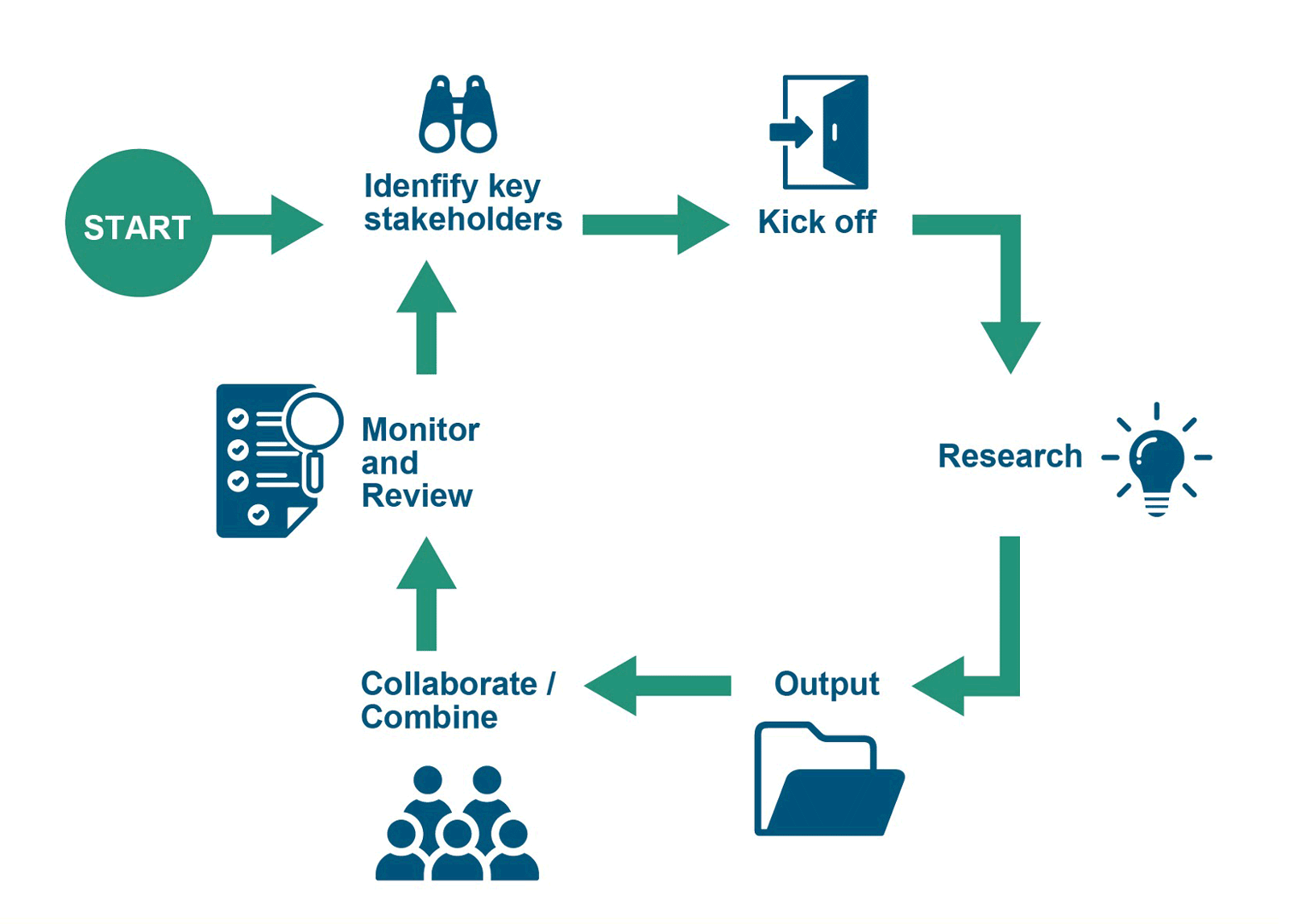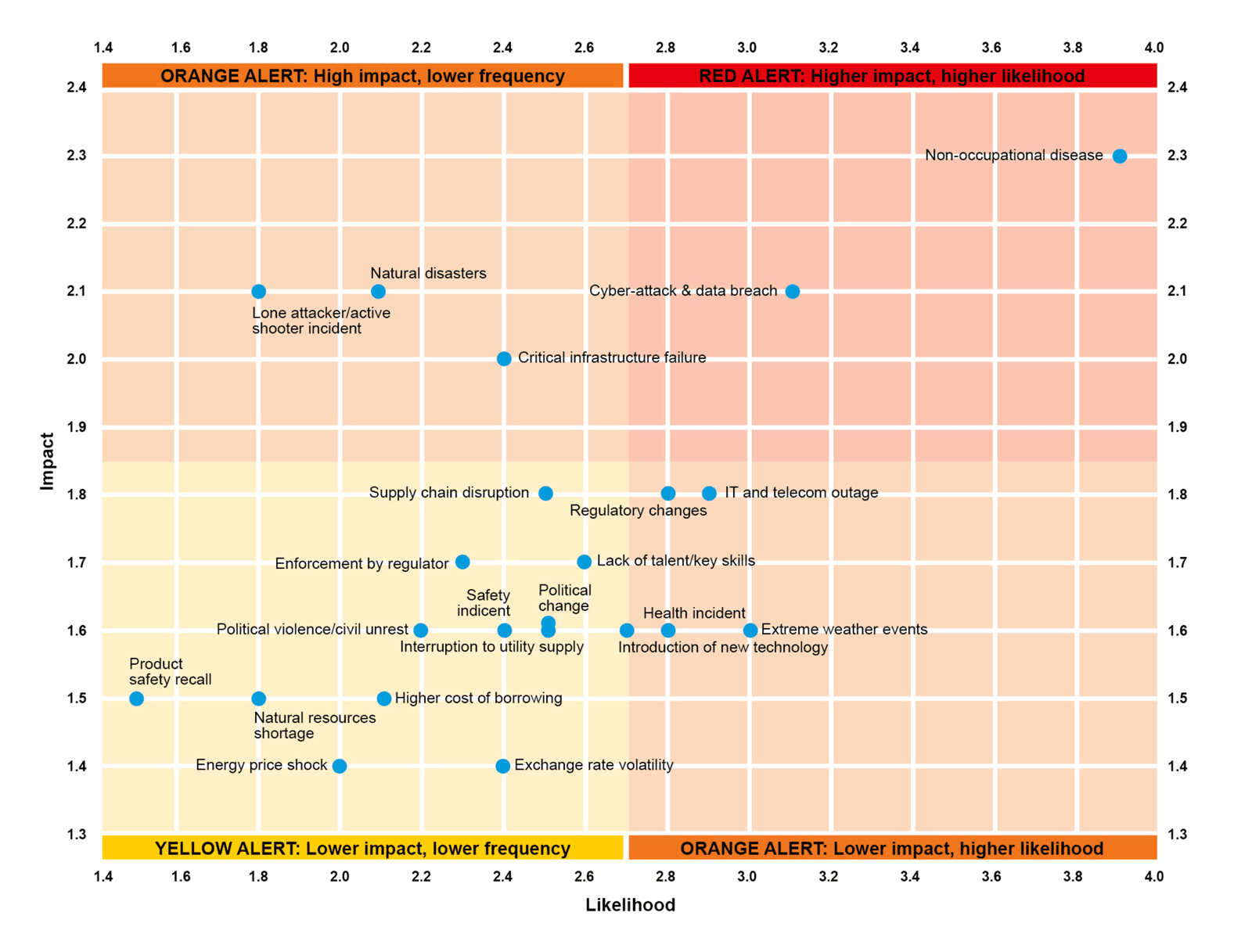The aim of a horizon scanning (HS) is not to predict the future but to improve understanding and review potential options and course of actions and ensure more informed decisions, which ultimately can help enhance resilience and preparedness in the face of uncertainty and change. HS is defined in various ways, including as:
- An organized and formal process of gathering, analyzing, and disseminating value-added information to support decision-making.
- A systematic examination of potential threats, risks, emerging issues, and opportunities, enables better preparedness.
Governments and large corporations frequently use HS as part of their overall planning processes. Smaller ports can also use HS and adapt it to reflect resources and capabilities. A HS can inform port strategic planning while keeping the scan relevant and updated.
The HS process is illustrated in figure 3.28
Figure 3: Horizon scanning process

Source: Institute of Risk Management (2018).
A port HS can cover issues, such as climate change mitigation and adaptation, cyber-risks, energy transition, changes in global trade patterns, and related implications for port calls and vessel routing. These issues entail both upside and downside risks that can be transformational and affect ports operations, business continuity, reputation, profitability, sustainability and resilience.
Risks can then be assessed in terms of the time horizon of their likely impacts by addressing the question of whether certain risks are likely to materialize and if so, when their effect is to be expected, i.e. over a short period, within 12 months; a medium period, 1-3 years); or a longer term, more than 3 years.
It is important to develop a framework for categorizing both risks and opportunities. It is also important to assess the potential impact of these risks on a port business, and the port's risk appetite. This will help determine the need to respond and the timeframe in which a response will be required. Figure 4 illustrates HS results.
Figure 4: Example of horizon scanning results

Source: BSI (2021).
The impact rating (high, medium and low) should reflect the specific context of each port. For example, a port with assets of only $1 million, a disruption causing an economic impact of $500,000 would be considered high as opposed to a port with assets worth $200 million. Determining the likelihood of occurrence can make use of relevant historical frequency data as available.
The rate at which information becomes available (i.e. the risk clock speed) is more important from a risk management perspective than the velocity or the speed at which the risks will occur. (Smith, 2010). When information needed to manage risk is available pre-event, detailed management steps can be implemented, including port plans for the arrival of mega vessels associated with collisions/accidents. Detailed information and related plans on common types of risk can be found in risk registers. These cases are known as "slow risk clock speed". This means ports have sufficient time to process, discuss and plan for action and response. An example of such risks would be limited water depth for ship docking. While the ship may not arrive until some months in the future, the tidal pattern is known well in advance. The port can therefore manage the risk that the ship may run aground through adequate planning. There are also instances where the information required to manage a given risk arrives in quick succession or close to real-time resulting in "fast risk clock speed risks".
It is crucial that any new material risks or significant changes to existing risks be communicated in an appropriate format to port senior management/Board. Stress-testing and scenario planning to assess the robustness of the port, in particular a port's financial situation, could be relied upon. The port's financial position is key to withstanding a risk event, e.g. having $100 million in cash resources, instead of $1 million (see scenario planning).
Horizon scanning should be carried out on an annual basis or appropriately updated where there is a known significant change in the risk environment; it can be completed relatively quickly in smaller port operations. Such HS can be achieved while using information, data and resources within the public domain. Only internal resources are required in many cases, but external expertise can be leveraged, if needed.
An effective HS will need to take into consideration existing biases and perspectives, namely:
- The heightened uncertainty – in terms of its impact and likelihood of risk/opportunity occurrence – associated with longer term timeframes and horizons.
- Over-focus on historical trends analysis and overlooking new trends and developments.
- Over-reliance on previous assessments and under-rating or ignoring weaker signals.
- Mis-rating of risks by over-rating the standard, known and understandable risks, while under-rating risks that are more complex and difficult to fully understand.
HINT
- Be particularly aware of technology changes and they present both opportunities and risks. Insights derived from industry bodies, competitors and customers, such as terminal operators or shipping companies, can be helpful.
- Engage multiple stakeholders across disciplines and departments.
Lessons learned from leading HS by the Government of the United Kingdom and Northern Ireland (Carney J., 2018) include the following:
- Don't think that HS is about predicting the future – this is a common misconception. The value of HS is to change mindsets, challenge assumptions, and provide more options.
- Don't look for 'what you know or want' – scanning is not the same as searching. This may seem contradictory, but it is one of the hardest commandments to get your mind around as a practitioner or a client. HS is about asking the 'unasked questions', or identifying the "unknown unknowns" (after Donald Rumsfeld).
- Don't negate the need for a champion or dedicated client – the major challenge for a HS analysis is in overcoming cultural resistance. A supportive and influential stakeholder is a great help – but choose wisely (if you can) and manage expectations accordingly.
- Don't forget to sustain the evidence base – a systematic and comprehensive scanning process provides a degree of (scientific) robustness, which is important for credibility.
- Don't think that there is any consistent understanding of what HS is about – there is a lack of a common understanding within the HS and futures community. The various disciplines that have contributed to HS have resulted in various views of what it is. Furthermore, the inconsistency of application means the term Horizon Scanning is widely used and, in many cases, mis-used. You should define your own terms and meanings.
- Don't be afraid to challenge your way of doing things – there is no magic (or agreed) recipe for how to do HS but watch out for thinking that the way you do it is the best and only way. Asking other teams to review your work is a great way to introduce new approaches and views to your HS activities.
- Don't forget 'the team' – use a dedicated cadre of 'generalists,' ideally recruited from different academic backgrounds (including the arts and the sciences). Consider the wider team too. Externals to your own area or consultants can often present an uncomfortable conclusion more effectively.
- Don't negate the need for impact – Focus on describing the implications of your analysis (the 'so what') rather than the process or detailed content. Also, remember that uncertainty and risk (or opportunity) are not the same thing.
- Don't expect to be thanked or enjoy it too much – HS is a challenging function, and at times you may feel like you are in the front line of a war zone. The most important contribution a futures project makes is likely to be an invisible one.
- Don't give up the day job – for some, HS may become a full-time or even life-long profession, but for most, it can be a useful adjunct to a more mainstream activity. Be wary that HS can seem like a cult at times but treat it not as a single bullet but rather another useful tool.
28 See IRM Horizon Scanning: A Practitioner’s Guide. https://www.theirm.org/media/7423/horizon-scanning_final2-1.pdf.
